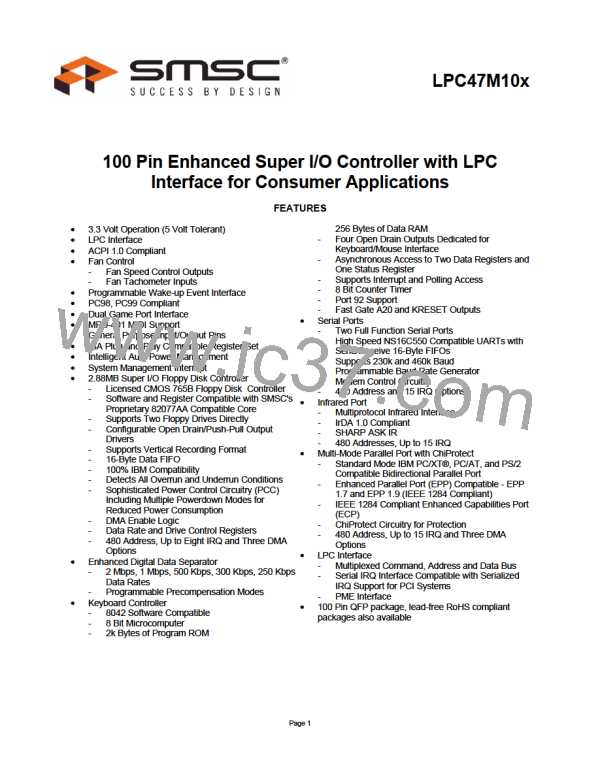ECP Operation
Prior to ECP operation the Host must negotiate on the parallel port to determine if the peripheral supports the ECP
protocol. This is a somewhat complex negotiation carried out under program control in mode 000.
After negotiation, it is necessary to initialize some of the port bits. The following are required:
Set Direction = 0, enabling the drivers.
Set strobe = 0, causing the nStrobe signal to default to the deasserted state.
Set autoFd = 0, causing the nAutoFd signal to default to the deasserted state.
Set mode = 011 (ECP Mode)
ECP address/RLE bytes or data bytes may be sent automatically by writing the ecpAFifo or ecpDFifo respectively.
Note that all FIFO data transfers are byte wide and byte aligned. Address/RLE transfers are byte-wide and only allowed
in the forward direction.
The host may switch directions by first switching to mode = 001, negotiating for the forward or reverse channel, setting
direction to 1 or 0, then setting mode = 011. When direction is 1 the hardware shall handshake for each ECP read data
byte and attempt to fill the FIFO. Bytes may then be read from the ecpDFifo as long as it is not empty.
ECP transfers may also be accomplished (albeit slowly) by handshaking individual bytes under program control in mode
= 001, or 000.
Termination from ECP Mode
Termination from ECP Mode is similar to the termination from Nibble/Byte Modes. The host is permitted to terminate
from ECP Mode only in specific well-defined states. The termination can only be executed while the bus is in the forward
direction. To terminate while the channel is in the reverse direction, it must first be transitioned into the forward direction.
Command/Data
ECP Mode supports two advanced features to improve the effectiveness of the protocol for some applications. The
features are implemented by allowing the transfer of normal 8 bit data or 8 bit commands.
When in the forward direction, normal data is transferred when HostAck is high and an 8 bit command is transferred
when HostAck is low.
The most significant bit of the command indicates whether it is a run-length count (for compression) or a channel
address.
When in the reverse direction, normal data is transferred when PeriphAck is high and an 8 bit command is transferred
when PeriphAck is low. The most significant bit of the command is always zero. Reverse channel addresses are seldom
used and may not be supported in hardware.
Table 45 -
Forward Channel Commands (HostAck Low)
Reverse Channel Commands (PeripAck Low)
D7
D[6:0]
0
Run-Length Count (0-127)
(mode 0011 0X00 only)
Channel Address (0-127)
1
Data Compression
The ECP port supports run length encoded (RLE) decompression in hardware and can transfer compressed data to a
peripheral. Run length encoded (RLE) compression in hardware is not supported. To transfer compressed data in ECP
mode, the compression count is written to the ecpAFifo and the data byte is written to the ecpDFifo.
Compression is accomplished by counting identical bytes and transmitting an RLE byte that indicates how many times
the next byte is to be repeated. Decompression simply intercepts the RLE byte and repeats the following byte the
specified number of times. When a run-length count is received from a peripheral, the subsequent data byte is replicated
the specified number of times. A run-length count of zero specifies that only one byte of data is represented by the next
data byte, whereas a run-length count of 127 indicates that the next byte should be expanded to 128 bytes. To prevent
data expansion, however, run-length counts of zero should be avoided.
Page 85

 SMSC [ SMSC CORPORATION ]
SMSC [ SMSC CORPORATION ]